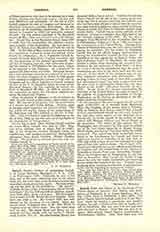

Carroll, DANIEL, brother of Archbishop Carroll, b. at Upper Marlboro, Maryland, U.S.A., 1733; d. at Washington, 1829. Politically he was, in his time, one of the most influential men of his native State, but the wider fame of his illustrious brother has somewhat overshadowed his repute. His early training was like that of the archbishop. “My father”, he wrote, December 20, 1762, to his kinsman, James Carroll, in Ireland, “died in 1750 and left six children, myself, Ann, John, Ellen, Mary and Betsey. My eldest sister Ann is married to Mr. Robert Brent in Virginia. They have one child a son. My brother John was sent abroad for his education on my return. Ellen, my second sister, is married well, to Mr. Wm. Brent in Virginia near my eldest sister. She has three boys and one girl. My sisters Mary and Betsy are unmarried and live chiefly with my mother” (Woodstock Letters, VII, 5). An elder brother, Henry, was drowned while a boy at school. Until the Revolution Daniel Carroll led the life of the country gentleman of the day, but it maybe noted that the Catholic men who had been sent abroad to school were far superior, as a class, to their neighbors, whose narrow and insular education rarely led them to interests beyond their county limits. Carroll was an active partisan of the colonists, serving as a member from Maryland of the old Colonial Congress (1780-1784). He was also a delegate from Maryland to the convention that sat in Philadelphia, May 14 to September 17, 1789, and framed the Constitution of the United States. Thomas Fitz-Simons of Pennsylvania was the only other Catholic among its members. On his return to Maryland, Carroll was by his efforts largely instrumental in having the Constitution adopted by that State. In opposition to the arguments of Samuel Chase, the Anti-Federalist leader in Maryland, he wrote and printed a public letter defending the proposed Constitution, the last sentences of which read: “If there are errors it should be remembered that the seeds of reformation are sown in the work itself and the concurrence of two-thirds of the Congress may at any time introduce alterations and amendments. Regarding it then in every point of view with a candid and disinterested mind I am bold to assert that it is the best form of government which has ever been offered to the world” (Maryland Journal, October 16, 1787). As one of the four laymen representing the Catholics of the United States, his name is signed to the address of congratulation presented to George Washington on his election as President of the Republic under the Constitution.
In the sessions of the new Congress Carroll served again (1789-1791) as a member from Maryland. When the Congress, at the session held in October, 1784, at Trenton, New Jersey, enacted that a board of three commissioners should lay out a site, between two and three miles square, on the Delaware for a federal city, to be the capital of the nation, he was named with Thomas Johnson and David Stuart as his associates. The choice of the present site of Washington was advocated by him, and he owned one of the four farms taken for it, Notley Young, David Burns, and Samuel Davidson being the others interested. The capitol was built on the land transferred to the Government by Carroll, and there is additional interest to Catholics in the fact that, in 1663, this whole section of country belonged to a man named Pope, who called it Rome. On April 15, 1791, Carroll and David Stuart, as the official commissioners of Congress, laid the cornerstone of the District of Columbia at Jones’s Point near Alexandria, Virginia. When the Congress met in Washington for the first time, in November, 1800, Carroll and Notley Young owned the only two really comfortable and imposing houses within the bounds of the city. Young’s name is among those assisting as collectors of subscriptions (1787) for the founding of Georgetown College.
THOMAS F. MEEHAN

